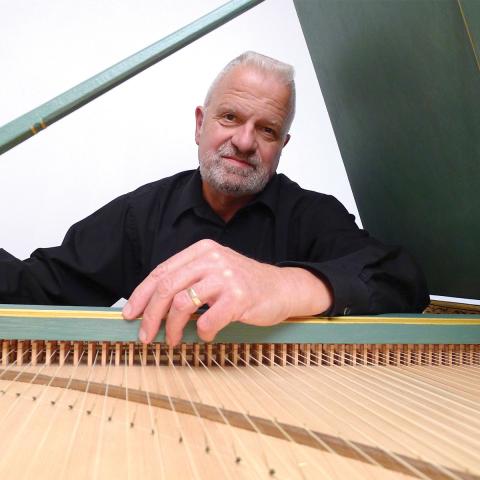Ennis Fruhauf, a native of Michigan, earned Bachelor and Master of Music degrees from the University of Michigan School of Music, and a Doctor of Musical Arts degree from the University of Southern California. Teaching appointments have included the University of California, Santa Barbara (1968–74), and Pomona College (1977–79), in combination with occasional church music positions serving Protestant and Catholic denominations. Fruhauf Music Publications was launched in 2004 and now offers a wide range of transcriptions, arrangements, and music compositions for organ, choir and organ, and carillon. FMP’s edition of Bach’s BWV 903 is one of numerous Baroque transcriptions available for concert or liturgical performance; it takes its place alongside seven collected volumes of original hymn tune settings for organ solo.

Bach’s aptly titled Chromatic Fantasia and Fugue in D Minor, BWV 903, is a composition for keyboard—clavichord, harpsichord, or pianoforte—that appears to have originated in the course of the composer’s tumultuous transition from Weimar to Cöthen in 1717. The year 1717 would include Bach’s fallout with his ducal patron, a curious trip to Dresden for an encounter with Louis Marchand (one that ended up with the theft of his prize purse), and a return to Weimar, where he faced imprisonment by the duke. The closing months of the year would see his subsequent release from restraint and the relocation of his household in order to serve in the court of the Prince of Cöthen.
A work-in-progress that spanned the composer’s lifetime, BWV 903 exists in numerous handwritten copies (Bach’s autograph does not survive), some having been prepared by or in the possession of students and admirers, including one that was kept by his eldest son, Carl Philipp Emanuel Bach. The earliest version, from Johann Tobias Krebs (ca. 1717), appears without the fugue; in subsequent copies (ca. 1730 and later) the fugue is present.
Other historical source copies come from Johann Friedrich Agricola (ca. 1740) and Johann Nikolaus Forkel (1800). The first printed editions were issued by Franz Anton Hoffmeister (1802) and Friedrich Konrad Griepenkerl (1819). Both movements were widely celebrated by Bach’s contemporaries and garnered acclaim in their matured form. In subsequent generations the opus was championed as a piano composition by Felix Mendelssohn, Franz Liszt, Johannes Brahms, and Feruccio Busoni, and as well as by Max Reger, who prepared a romanticized transcription for organ.
The Fantasia was widely celebrated by Bach’s contemporaries and garnered acclaim in its matured form. It displays a vast array of dramatic and rhapsodic gestures, including extensive passages notated as block chords but labeled “arpeggiando” (see examples in measures 28–29 and 31), and a section presented in recitativo format. A harbinger of some of the most angst-laden portions of Bach’s Leipzig passions, cantatas, and Masses, the Fantasia takes the shape of an impassioned and highly improvisatorial diatribe, made up of passaggio declamations and extensive undulating chordal expeditions into distant keys and tonal areas, all bound together with operatic recitativos and bold cadences.
The Fugue, likely added to the Fantasia during Bach’s early Leipzig years, displays his contrapuntal skill and expertise with its energetic but lean-textured presentation and artfully timed progression of subject statements, episodic developments, and bold tonal excursions. There is no cadenza at the Fugue’s conclusion: as such it would have been redundant. Instead there is simply a final flourish and closing cadence on a Picardy-third tonic chord.
Why a new edition?
The foregoing informal review of Bach’s BWV 903 is provided as an introduction to a complimentary publication. Bach’s Chromatic Fantasy and Fugue, BWV 903, is a virtuoso work composed for harpsichord (though in our day it is also performed by pianists). Nonetheless, the Fantasia and Fugue also lends itself ideally to the greatly enhanced range of tonal explorations and dramatic interpretations to be found at an organ console. The present transcription was prepared with the primary purpose of realizing, or detailing, the extensive sections of arpeggiando chords and extracting an idiomatic pedal part. Occasional ornamentation has been added throughout, and the score is intended as a teaching and performing edition, outlining a stylistically viable interpretation in keeping with the composer’s Baroque traditions, harmonic languages, and techniques. It will be noted that beam directions have been edited to indicate hand alternations in the Fantasia’s solo passaggio sections. Visual cues for manual changes and relative dynamics are present as well. Each page of the score portrays a roadmap for performance, offering up yet another reading of a rare Bach gem—one more in a long line of revisitations throughout its 300-year “work-in-progress” history.
A letter-sized booklet issue is available online as a complimentary PDF file download, offered by Fruhauf Music Publications with the hope that BWV 903 will be revisited anew and performed to best advantage. Visit www.frumuspub.net’s home page Bulletin Board for access to the file.



